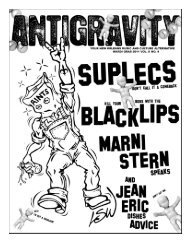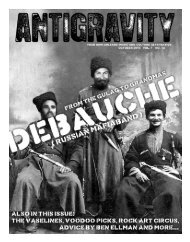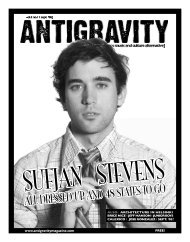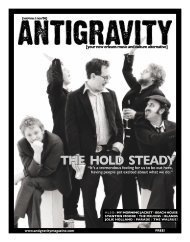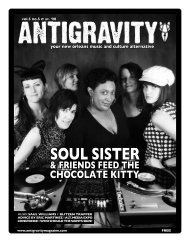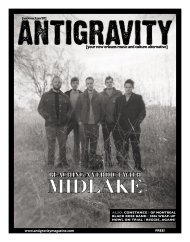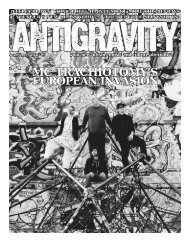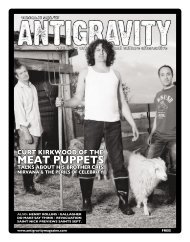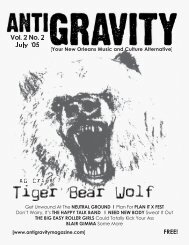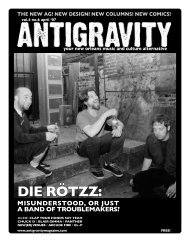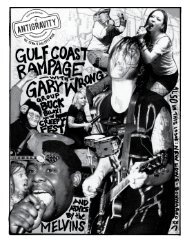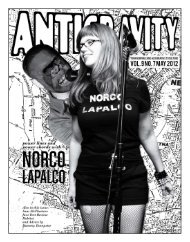September 2008 (PDF) - Antigravity Magazine
September 2008 (PDF) - Antigravity Magazine
September 2008 (PDF) - Antigravity Magazine
Create successful ePaper yourself
Turn your PDF publications into a flip-book with our unique Google optimized e-Paper software.
COLUMNMEDICINE<br />
DR. FEELGOOD<br />
CAN YOU HEAR ME NOW?<br />
by nancy kang nancy@antigravitymagazine.com<br />
Dr. Nancy Kang Joins ANTIGRAVITY this month as its resident medical<br />
expert. Feel free to write Dr. Kang at the email address below with any<br />
medical questions, and go see her band, Glorybee, <strong>September</strong> 20th at the<br />
Circle Bar with the Broken Smokes.<br />
There I was, right in<br />
the very front of One<br />
Eyed Jacks and next<br />
to a ten-foot speaker at the<br />
Melvins concert. The show<br />
was great and I nearly suffered<br />
traumatic brain injury from<br />
myriad flailing steel-toed boots.<br />
Afterwards, out on the street,<br />
the silence would have been<br />
deafening had it not been for<br />
the horrid ringing in my ears,<br />
which lasted for three days. But<br />
I’m all right now. Or am I? I am<br />
sure you have left a concert with ringing ears, or maybe with temporary hearing<br />
loss. One of the thrills of going to a show (or playing one) is the feel of megaamps<br />
turned way up to eleven. But is there a permanent cost? More and more<br />
younger people are being diagnosed with noise-induced hearing loss. Modern<br />
day noise exposure is unrelenting: concerts, cell phones, movies and ear buds<br />
hooked to iPods continuously blaring the soundtrack to our lives, for example.<br />
Noise-induced hearing loss lasts forever and can be devastating, especially to the<br />
professional musician or music aficionado. Hearing aids can help, but the best<br />
medicine is prevention.<br />
The loudness of the sound (called intensity and measured in decibels) and the<br />
length of time exposed to it are two important factors. Noise-induced hearing loss<br />
is also cumulative over time. It’s like walking on a grass lawn: you may step on<br />
it and see some temporary footprints, but soon they go away, but tread roughly<br />
on the grass over many years and it will not grow there anymore. Exposure to<br />
loud sounds for lengthy periods of time can injure delicate cells of the inner ear<br />
in a similar fashion. Preventing damage to the inner ear, our organ of hearing, is<br />
the key. Short-term exposures of sound levels above 100 decibels (dB) can cause<br />
hearing loss. To put this in perspective, normal conversation is around 55 dB, a<br />
whisper 15 dB, and a lawnmower 90 dB. Sound levels at concerts can range from<br />
120 to 140 dB. iPod ear buds are especially worrisome for hearing damage, as<br />
they go directly in to the ear canal and are used by many people for long periods<br />
of time. iPods and other portable music players can reach sound levels of 130 dB,<br />
which can cause damage after only thirty minutes.<br />
Do you already have some hearing loss? If you are a musician or go to lots<br />
of shows, the answer might be “yes.” Early signs of noise-induced hearing loss<br />
include the following: having trouble understanding what people say, especially<br />
in crowded places like restaurants; having to ask people to repeat themselves;<br />
inability to hear high pitched sounds like the telephone ringing, and ringing in the<br />
ears, called “tinnitus.”<br />
Perhaps you’ve tried cheapo earplugs from the drug store at a concert, just to<br />
end up taking them out. If you are hardcore about maintaining the fidelity of the<br />
music, you can have custom-made musician earplugs for around $175. Musician<br />
plugs are custom-made for your ear canals by a hearing specialist (usually an<br />
Audiologist). An ear impression material (usually silicone) is injected into your ear<br />
canal and the result is sent to a lab, where an ear mold is made with a custom filter<br />
that reduces the sound. These molds are special because they are so comfortable,<br />
as they’re custom made for you, but also because they provide a fidelity that no<br />
other hearing protection can offer. Foamy earplugs or headsets reduce the sounds<br />
of the high frequencies more than the low frequencies, but musician plugs reduce<br />
all sounds uniformly. For more information on custom musician earplugs or for a<br />
hearing evaluation, contact an audiologist or your doctor.<br />
So see you at the Maple Leaf but bring your own (EAR) protection!<br />
This column serves the public health interest of New Orleans’ music<br />
community and is not meant as medical advice. For medical treatment or<br />
counseling, seek care from a medical professional.<br />
8_antigravity: your new orleans music and culture alternative



